Visiting Azuchi Castle?
If you are looking for things to do near the ruins, don’t limit your trip to climbing the mountain alone.
Within walking distance from Azuchi Station, more than 17 Nobunaga-related sites remain — including museums, shrines, springs, temples, and former castle-town landmarks that survived the fall of Azuchi Castle.
This page is an English guide to what to see around Azuchi Castle, with a ready-to-use walking route, short visiting times for each stop, and practical access tips to help you plan a half-day exploration.
- Walking Route – Nobunaga Spots Around Azuchi Castle
- Castle Navi Museum
- Dodobashi Entrance
- Dodobashi Bridge
- Kenshi no Tsuji (Kenshi Crossroads)
- Shingu Taisha (Shrine Linked to Nobunaga and Bamboo Sumo)
- Ikutsuhikone Shrine (Shrine Linked to Nobunaga and Azuchi Castle)
- Azuchi Seminary Site
- Azuchi Castle Outer Moat Decks 1 & 2
- Shiga Prefectural Azuchi Castle Archaeological Museum
- Former Miyaji Residence
- Azuchi Castle Tenshu – Nobunaga no Yakata Museum
- Tenka Fubu Song Monument
- Azuchi Castle Museum
- Jogonin Temple
- Chokoji Temple (Relocated Back Gate of Sokenji Linked to Oda Nobunaga)
- Saikoji Temple (Jodo Sect Temple Associated with Oda Nobunaga)
- Daibizan Kotakuji Temple
- Other Nearby Spots
- Azuchi Castle – Full Map
- Azuchi Castle Guide
- Back to Oda Nobunaga’s Main Page
Walking Route – Nobunaga Spots Around Azuchi Castle
The legendary Azuchi Castle, built by Oda Nobunaga, is often referred to as a phantom masterpiece. Scattered around the area are numerous historical sites and cultural landmarks that still convey Nobunaga’s legacy today. Deepen your knowledge at the Castle Navi Museum, then stroll through the streets of Azuchi—rich with the romance of the Sengoku era—as you visit sites such as the Momobashi Entrance, Ishibe Shrine, and the ruins of the Azuchi Seminary.
Castle Navi Museum
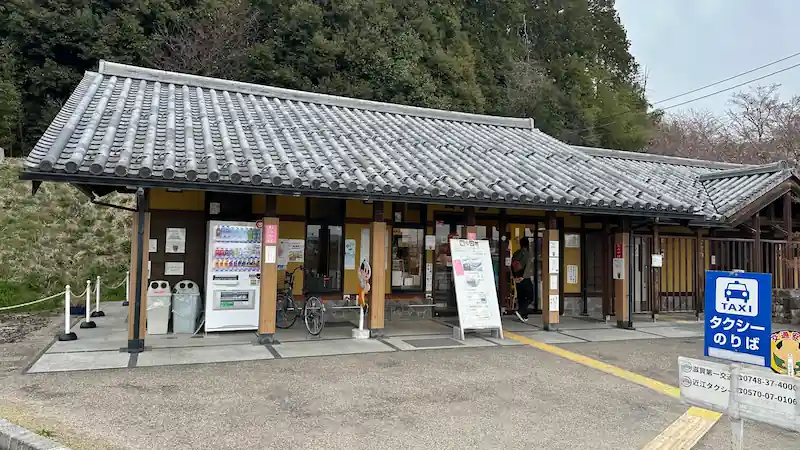
🏛 Overview
The Castle Navi Museum is a guidance facility located near the entrance to the Azuchi Castle ruins. It introduces visitors to the history and highlights of Azuchi Castle. Inside, you’ll find exhibits and information about the castle, making it an ideal place to gain background knowledge before your visit. Original Azuchi Castle-themed goods and local specialties are also available for purchase, perfect as souvenirs or keepsakes of your trip.
Additionally, the museum includes a rest area where complimentary tea is provided. It’s a great spot to relax and gather information before heading up to the castle.
Opening Hours
9:00 AM – 5:00 PM
Admission Fee
Adults: 200 yen / Elementary & Junior High Students: 100 yen / Free for children under elementary school age
Closed
Mondays (except holidays), the day after holidays, and New Year’s holidays
Official Website
https://www.city.omihachiman.lg.jp/soshiki/kanko/3/4/6/15799.html
🗺 Address: Shimo Toyoura, Azuchi-cho, Omihachiman City, Shiga Prefecture
🚶 Access
About 1-minute walk (approx. 36m) from Azuchi Castle
⏳ Suggested Visiting Time
- Quick visit: around 10 minutes
- Thorough exploration: around 20 minutes
📍 Highlights
- Azuchi Castle Exhibits: Panels and models showcasing the history and structure of Azuchi Castle help you better understand the site before visiting.
- Exclusive Goods: A range of unique Azuchi Castle-related items and local specialties are available for purchase here.
- Rest Area: Complimentary tea is offered in the rest space, making it a pleasant stop before or after visiting the castle.
📌 Trivia
- Surprising Historical Context: The Castle Navi Museum serves as a guidance center, conveying the history and charm of Azuchi Castle to visitors.
- Insider Information: The museum also screens DVDs about Azuchi Castle, allowing visitors to learn visually about its history.
- Connection to Famous Figures: Azuchi Castle is renowned as a masterpiece built by Oda Nobunaga, and the museum traces both the castle’s history and Nobunaga’s legacy.
Dodobashi Entrance
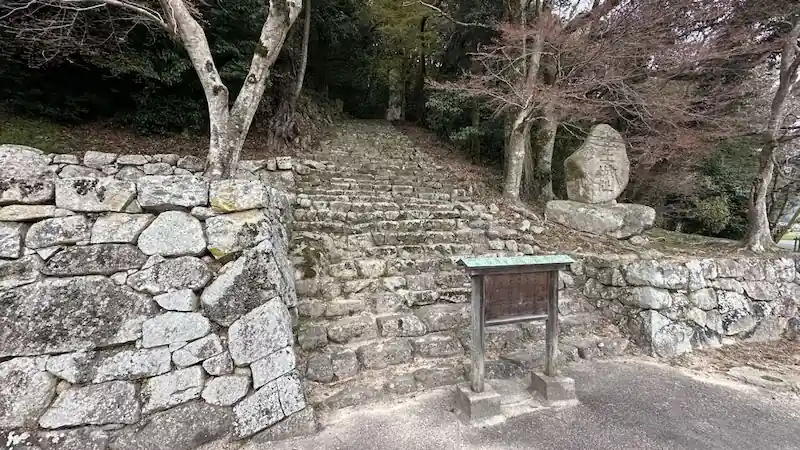
🏛 Overview
The Dodobashi Entrance was once one of the main gates to Azuchi Castle, serving as its primary front entrance during the era of Oda Nobunaga. From this point, a path led through Sōken-ji Temple and continued into the castle grounds, used by visitors and retainers of the time. Today, access via the Dodobashi Entrance is restricted, with most visitors entering via the Otemichi route.
The stone steps at Dodobashi are steep and are known as “Umagaeshi-zaka,” meaning “Horse-Return Slope,” a name that arose because it was too steep for horses to ascend. These steps are believed to have served as part of the castle’s defensive features.
The path leading from the Dodobashi Entrance is called “Dodobashiguchi Road,” which passes through the Niōmon Gate of Sōken-ji Temple and into the castle. This route is mentioned in historical records, offering insights into how visitors ascended to the castle in Nobunaga’s time.
Although you can no longer ascend to the castle from the Dodobashi Entrance, exploring the exterior and surrounding area still allows you to sense the atmosphere of the past.
| Year of Construction | 1576‑1579 |
|---|---|
| Builder | Oda Nobunaga (Chief Supervisor: Niwa Nagahide) |
| Structure / Features | Stone steps at the mountain base; stone walls (Nozura-zumi and Sangi-zumi styles) |
| Renovation / Restoration | Natural weathering after Edo period; surrounding area maintained during the Showa period |
| Current State | Remains of stone steps and walls; some sections are closed to visitors |
| Destruction / Damage | After the castle’s destruction, the route remained as a mountain path |
| Cultural Property Status | Azuchi Castle Ruins designated as a National Special Historic Site |
| Notes | The only major route passing through the Sōken-ji Temple ruins |
Partway up the Dodobashi steps, a path to the left leads to Ishibe Shrine.
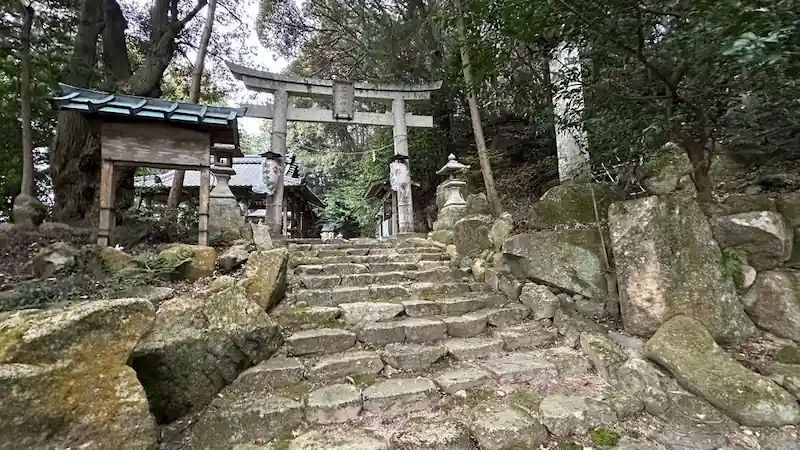
About Ishibe Shrine
Deities Enshrined
Sukunahikona no Mikoto, Amaterasu Omikami, Takamimusubi no Kami, and Onamuchi no Mikoto
Ishibe Shrine has long been revered by the local people of this area. According to tradition, it was founded in the 21st year of Emperor Keikō’s reign (93 CE) and was originally called “Ishibe Shrine Tenjin Takamiya.” When the shrine buildings were constructed, imperial envoys visited and grand festivals were reportedly held.
Later, the shrine was moved to a hill on the southern lakeside of Mount Azuchi and came to be known simply as “Ishibe Shrine.” In 925 CE, during the Heian period, it was listed in the prestigious “Engishiki Jinmyōchō” (Register of Deities), gaining recognition as a historically significant “Shikinai-sha” shrine.
During the era of Empress Kōken, prominent figures such as Tachibana no Moroe and Fujiwara no Toyonari deeply revered the shrine, dedicating sacred treasures including swords, jewels, and sakaki branches used in rituals.
In the Sengoku period, when Oda Nobunaga built Azuchi Castle, this shrine was enshrined as the castle’s guardian deity. Nobunaga also oversaw the shrine’s restoration and revival of its festivals. Although many treasures and documents were later lost during subsequent conflicts, records of its significance remain.
National Treasure: Seated Wooden Statue of Yakushi Nyorai
The grounds house a seated wooden statue of Yakushi Nyorai, believed to date from the Heian period. The accompanying miniature shrine (zushi) bears an inscription from 1391 (Meitoku 2) and was designated a National Treasure in 1911 (Meiji 44). Today, it is occasionally displayed at the Kyoto National Museum.
🗺 Address: Shimo Toyoura, Azuchi-cho, Omihachiman City, Shiga Prefecture
🚶 Access
About 5-minute walk (approx. 350m) from Azuchi Castle
⏳ Suggested Visiting Time
- Quick visit: around 15 minutes
- Thorough exploration: around 30 minutes
📍 Highlights
- Stone Steps of Dodobashi: The steep steps, also called “Umagaeshi-zaka,” reflect the castle’s defensive design.
- Niōmon Gate of Sōken-ji Temple: Located along the Dodobashiguchi Road, this gate is a historically significant structure.
- Seasonal Scenery: Cherry blossoms in spring and colorful foliage in autumn beautifully complement the historic ruins.
📌 Trivia
- Surprising Historical Context: The Dodobashi Entrance served as the main front gate of Azuchi Castle during Nobunaga’s era.
- Insider Information: The name “Umagaeshi-zaka” comes from the fact that horses could not ascend its steep steps.
- Connection to Famous Figures: This route was historically used by Oda Nobunaga and his retainers to ascend the castle.
Dodobashi Bridge
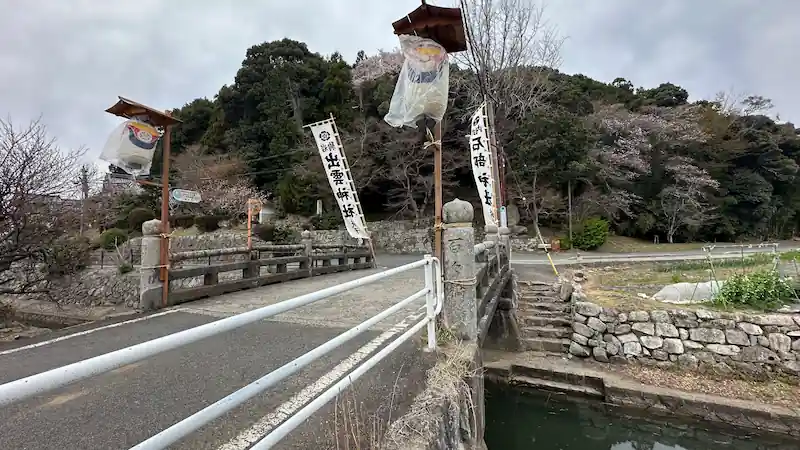
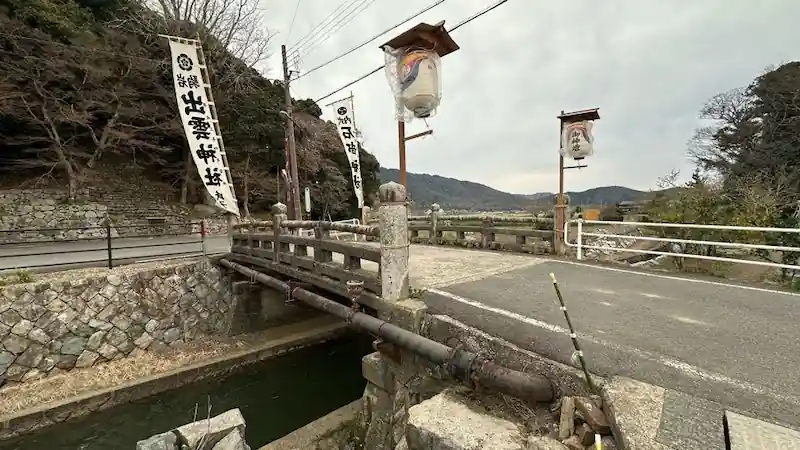
⭐ Recommendation
Historical Value: ☆☆☆
Visual Appeal: ☆☆
Experiential Value: ☆
Dodobashi Bridge is a stone bridge located in Azuchi-cho, Omihachiman City, Shiga Prefecture. It once spanned the outer moat of Azuchi Castle and marked the entrance to the back approach known as “Dodobashiguchi” leading into the castle built by Oda Nobunaga. The current bridge was reconstructed in 1957 (Showa 32), but its name has been preserved, carrying forward the atmosphere of the historic route used in Nobunaga’s time.
| Year of Construction | Late 16th century (Nobunaga era) |
|---|---|
| Builder | Oda Nobunaga (as part of castle infrastructure) |
| Structure / Features | Stone bridge; reconstructed in Showa period using concrete; ornamental giboshi (onion-shaped finials) on the railings. |
| Renovation / Restoration | Rebuilt in 1957 (equivalent to Showa 32). |
🗺 Address: Shimo Toyoura, Azuchi-cho, Omihachiman City, Shiga Prefecture
🚶 Access
Directly in front of Dodobashi Entrance
⏳ Suggested Visiting Time
Quick visit: around 5 minutes
Thorough exploration: around 20 minutes
📍 Highlights
- Dodobashiguchi (Castle Approach): A back route used by Nobunaga, his retainers, and commoners for pilgrimages or castle visits. Records mention stone walls collapsing during crowded New Year visits.
- Bridge and Railing Design: Though rebuilt in concrete, the bridge retains traditional elements such as giboshi-style finials, evoking its historic appearance.
- Seasonal Scenery: In spring, enjoy cherry blossoms and views of Nishinoko Lake from the Sōken-ji Temple ruins; in autumn, admire the colorful foliage along the stone steps and mountain base.
📌 Trivia
- Surprising Historical Context: According to the “Shinchō Kōki,” the bridge’s route to Azuchi Castle saw a stone wall collapse during New Year’s visits in Nobunaga’s era, causing casualties.
- Insider Information: At the west end of the bridge stands a boundary marker erected by the Ministry of Home Affairs during the Meiji–early Showa period, a remnant of former castle-site administration.
- Connection to Famous Figures: During the Meiji–Showa era, Tokutomi Sohō contributed to preserving Mount Azuchi and is said to have been asked to inscribe the characters on the Dodobashiguchi stone marker.
Kenshi no Tsuji (Kenshi Crossroads)
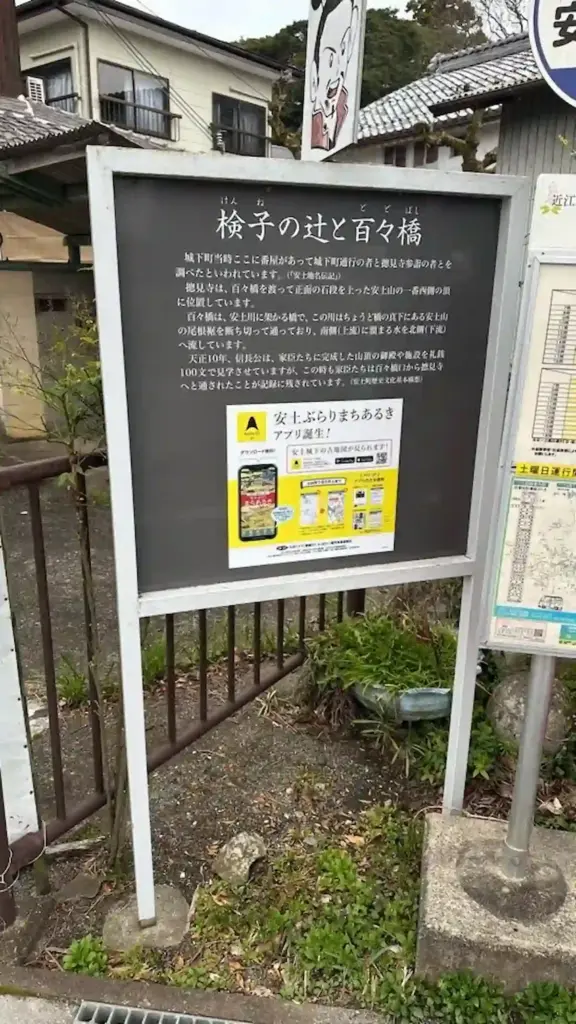
⭐ Recommendation
Historical Value: ☆☆
Visual Appeal: ☆
Experiential Value: ☆
“Kenshi no Tsuji” preserves the atmosphere of the castle town built by Oda Nobunaga at Azuchi. Once a bustling crossroads where lords and retainers passed through daily, it is now part of a well-maintained walking route. The spot evokes the lifestyle of the castle town centered around Nobunaga, and nearby you can also find the remains of the Seminario, a Christian seminary granted by Nobunaga—an area where religion and politics intertwined. Walking through this district allows you to imagine the structure and daily life of the Azuchi castle town and experience its historical essence.
| Year of Construction | Late 16th century (Azuchi Castle construction period) |
|---|---|
| Builder | Oda Nobunaga |
| Structure / Features | None |
| Renovation / Restoration | Castle town redevelopment and tourist walking path improvements (recent) |
| Current State | Walking path |
| Destruction / Damage | No surviving buildings; only terrain and remains |
| Cultural Property Status | Part of the Azuchi Castle Ruins, designated as a National Special Historic Site |
| Notes | Included in the broader walking route of Azuchi’s historic townscape |
🗺 Address: Azuchi-cho, Omihachiman City, Shiga Prefecture
🚶 Access
1-minute walk (approx. 50m) from Dodobashi
⏳ Suggested Visiting Time
Quick visit: around 5 minutes
Thorough exploration: around 10 minutes
📍 Highlights
- Stone Monument: Serves as a historical marker showing the old castle town road network, adding context to your walk.
- Surrounding Old Townscape: Edo-period machiya townhouses and narrow alleyways remain, evoking the atmosphere of the past.
- Seasonal Scenery: In spring, the weeping cherry trees in the castle town bloom beautifully, adding color to the walking route.
📌 Trivia
- Surprising Historical Context: Kenshi no Tsuji was a key hub of daily life in the castle town built by Nobunaga, frequented by retainers and merchants alike.
- Insider Information: Nearby lies the site of the “Seminario,” granted by Nobunaga for church construction, reflecting traces of cross-cultural exchange of the era.
- Connection to Famous Figures: The town roads laid out under Nobunaga’s urban planning can still be walked today as part of the sightseeing route.
Shingu Taisha (Shrine Linked to Nobunaga and Bamboo Sumo)
⭐ Recommendation
Historical Value: ☆☆☆
Visual Appeal: ☆☆
Experiential Value: ☆☆
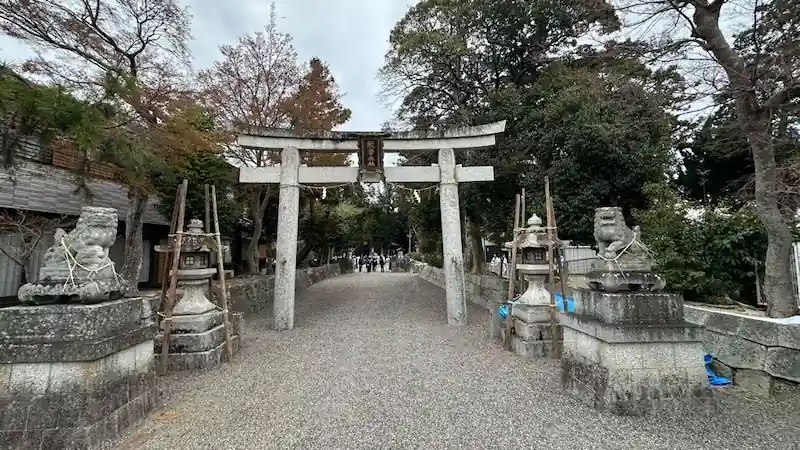
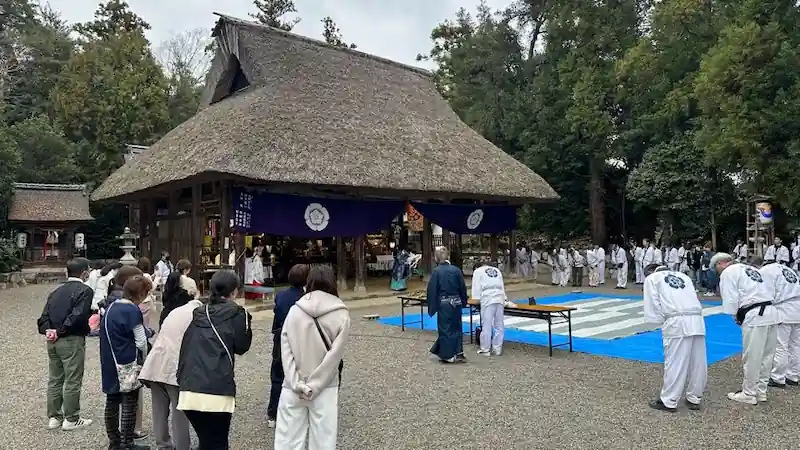
Shingu Taisha is an ancient shrine in Azuchi-cho, Omihachiman City, with strong historical ties to Oda Nobunaga. It is said to be the birthplace of the “Bamboo Sumo” matches that Nobunaga loved to host. Within the shrine grounds are votive plaques (ema) and monuments commemorating this tradition. One tale recounts Nobunaga awarding the surnames “East” and “West” to two equally matched wrestlers, a story still preserved today. Large ema donated by the descendants of these families draw visitors’ attention. The thatched-earth prayer hall and the Bamboo Sumo monument offer a glimpse into Sengoku-period culture and Nobunaga’s character.
| Founded | Ancient–Medieval period (exact year unknown; existed by around 1403) |
|---|---|
| Enshrined Deities | Hayatamano-no-Mikoto and others (Main, Sacred, and Young Shrines) |
| Structure / Features | Thatched-earth prayer hall, Bamboo Sumo votive plaques, commemorative monument |
| Renovation / Restoration | Preserves medieval structures; recent plaque offerings and monument installation |
| Current State | Main and prayer halls preserved; shrine forest intact |
| Cultural Property Status | Not listed (confirm for municipal cultural property status) |
| Notes | Features in Bamboo Sumo re-enactments and Nobunaga Festival; local traditions remain vibrant |
🗺 Address: 3319 Shimotoyoura, Azuchi-cho, Omihachiman City, Shiga Prefecture
🚶 Access
2-minute walk (about 130m) from Kenshi no Tsuji
⏳ Suggested Visiting Time
Quick visit: around 10 minutes
Thorough exploration: around 30 minutes
📍 Highlights
- Thatched-earth Prayer Hall: A rare local example of reed-thatched shrine architecture showcasing traditional beauty.
- Bamboo Sumo Votive Plaques: Powerful ema illustrating the story of Nobunaga’s bamboo sumo contests.
- Bamboo Sumo Monument: A commemorative monument preserving the legend; bamboo sumo reenactments are held during the Nobunaga Festival.
- Seasonal Events: During the “Azuchi Nobunaga Festival” (first Sunday in June), visitors can enjoy bamboo sumo reenactments and warrior parades hosted by locals.
📌 Trivia
- Surprising Historical Context: One theory suggests Nobunaga’s bamboo sumo matches, where he named wrestlers “East” and “West,” inspired the modern sumo ring’s East–West designations.
- Insider Information: The ema were painted by local artist Eiichi Shiotani and donated by descendants of the East and West families, preserving both artistry and local tradition.
- Connection to Famous Figures: Nobunaga’s fondness for sumo is documented even in missionary Luís Fróis’s “History of Japan,” offering a rare glimpse into the daimyo’s personal side.
Ikutsuhikone Shrine (Shrine Linked to Nobunaga and Azuchi Castle)
⭐ Recommendation
Historical Value: ☆☆☆
Visual Appeal: ☆☆
Experiential Value: ☆☆
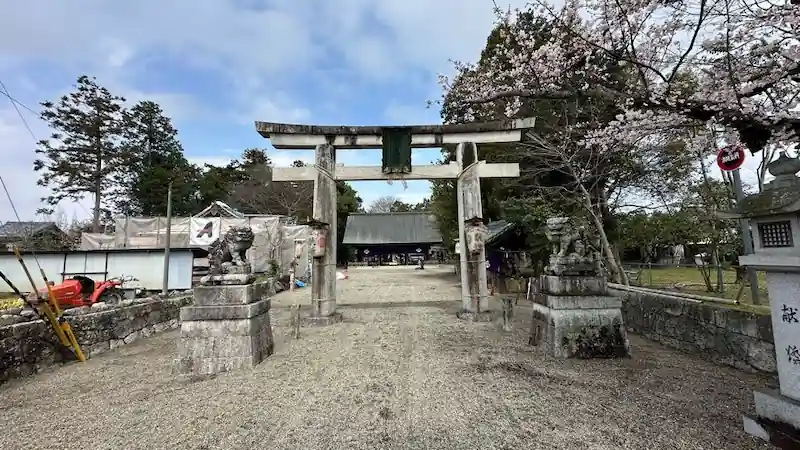
Ikutsuhikone Shrine is an ancient shrine located in Azuchi-cho, Omihachiman City, enshrining Ikutsuhikone-no-Mikoto. It is said that in 1576 (Tenshō 4), Oda Nobunaga visited this shrine during the construction of Azuchi Castle to pray for peace in the realm, abundant harvests, military success, and the safety of the castle, making offerings as well. Known as a sacred site associated with Nobunaga, the shrine has long been revered as the guardian deity of the area.
| Founded | Unknown (Ancient to Medieval period) |
|---|---|
| Enshrined Deity | Ikutsuhikone-no-Mikoto |
| Structure / Features | Prefecture-designated wooden shrine buildings; Heiden and corridors; existing worship hall and main hall |
| Renovation / Restoration | Main hall built in the Edo period (Kan’ei era); treasure house later lost to fire |
| Current State | Main hall, worship hall, and precincts well preserved |
| Destruction / Damage | Treasure house burned down during Azuchi Castle’s destruction in 1582; documents and treasures lost |
| Cultural Property Status | City-designated Important Cultural Property (Main Hall: Sangensha Nagare-zukuri style) |
| Notes | Close to Dodobashi and Azuchi Castle ruins; ideal for combined visits |
🗺 Address: 4272 Shimotoyoura, Azuchi-cho, Omihachiman City, Shiga Prefecture
🚶 Access
⏳ Suggested Visiting Time
Quick visit: around 20 minutes
Thorough visit: 45 minutes to 1 hour
📍 Highlights
- Main Hall (Sangensha Nagare-zukuri): Built during the Kan’ei era (circa 1626), designated as a City Important Cultural Property, showcasing traditional architectural style.
- Heiden, Corridors, and Worship Hall: Quiet, elegant structures evoking the atmosphere of Nobunaga’s era.
- Monuments and Dedication Paintings: Includes poetry monuments by Fujiwara Toyonari and other dedications scattered throughout the grounds.
- Seasonal Events: During the Azuchi Nobunaga Festival (first Sunday in June), warrior processions pass by the shrine, making it perfect to combine with visits to Dodobashi and the Azuchi Castle ruins.
📌 Trivia
- Surprising Historical Context: While the treasure house burned during the fall of Azuchi Castle, the main hall survived, preserving its Edo-period structure.
- Insider Information: The enshrined deity, Ikutsuhikone-no-Mikoto, is linked to the origin of the name “Hikone,” showing deep ties between the shrine, the place name, and later Hikone Castle lords.
- Connection to Famous Figures: Ii Naotaka, later lord of Hikone Castle, also revered this shrine and enshrined its divided spirit at Hikone Castle as Hikone Shrine.
Ikutsuhikone Shrine is a historically significant site where Oda Nobunaga is said to have prayed for safety during the construction of Azuchi Castle. Its tranquil atmosphere and deep historical roots make it an essential stop when exploring Azuchi Castle ruins, Dodobashi, and other Nobunaga-related landmarks in the area.
Azuchi Seminary Site

⭐ Recommendation
Historical Value: ☆☆☆
Visual Appeal: ☆☆
Experiential Value: ☆☆
In 1580, with the approval of Oda Nobunaga, Jesuit missionary Father Organtino established Japan’s first Christian seminary here. The magnificent three-story building provided comprehensive education in theology, languages, and music. Nobunaga himself is recorded to have visited and listened to the students’ organ performances.
| Year of Construction | 1580 (Tenshō 8) |
|---|---|
| Founder | Father Organtino (Jesuit missionary), supported by Oda Nobunaga |
| Structure / Features | Three-story building with tea room and dormitory; multifunctional seminary |
| Renovation / Restoration | None (current site maintained as a park) |
| Current State | Stone monument, explanatory boards, and park |
| Destruction / Damage | Burned down in 1582 |
| Cultural Property Status | Part of Azuchi Castle Ruins (National Historic Site) |
| Notes | Remnants of historical waterways partially preserved |
🗺 Address: 2753 Shimotoyoura, Azuchi-cho, Omihachiman City, Shiga Prefecture
🚶 Access
6-minute walk (about 400m) from Kenshi no Tsuji
⏳ Suggested Visiting Time
Quick visit: around 10 minutes
Thorough exploration: around 30 minutes
📍 Highlights
- Stone Monument and Information Boards: Learn in detail about Father Organtino, Paul Miki, and the seminary’s history.
- Tranquil Park Setting: Beautifully landscaped with cherry trees and remnants of waterways, ideal for a quiet stroll.
- Seasonal Appeal: Cherry blossoms in spring create a serene and colorful atmosphere.
📌 Trivia
- Japan’s First Christian Seminary: Offered wide-ranging studies in Japanese, Latin, and music; educated many young students including Paul Miki.
- Built on Former Castle Waterways: The seminary site repurposed parts of the castle town’s inlets and water routes for access and function.
- Musical Connection to Nobunaga: Anecdotes recount Nobunaga enjoying the students’ organ performances, highlighting early cross-cultural exchanges.
Azuchi Castle Outer Moat Decks 1 & 2
⭐ Recommendation
Historical Value: ☆☆☆
Visual Appeal: ☆
Experiential Value: ☆☆
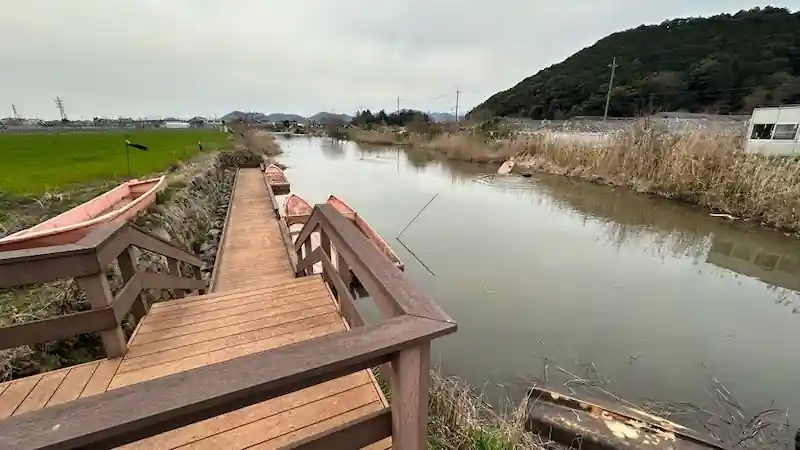
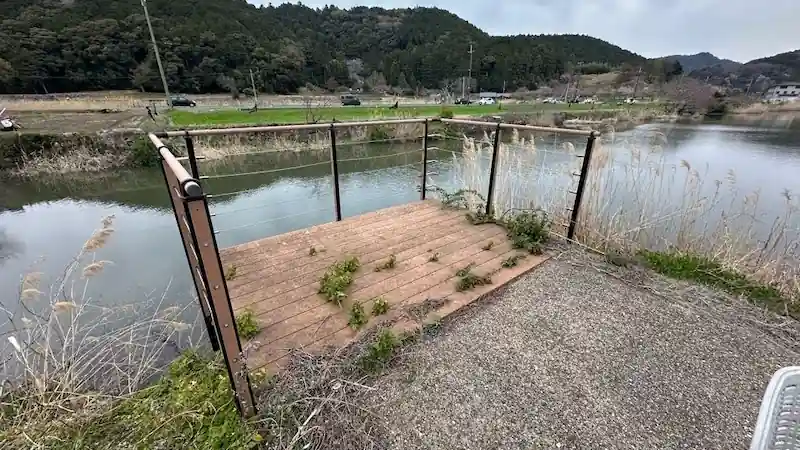
The “Outer Moat Decks” near the Azuchi Castle ruins are part of a walking route that circles the outer perimeter of the castle site. These decks offer direct views of the castle’s outer moat, providing an evocative experience of Nobunaga’s grand vision for unifying the realm and the scale of the castle’s construction.
| Year of Construction | 1576–1579 |
|---|---|
| Builder | Oda Nobunaga |
| Structure / Features | Wooden observation decks overlooking the outer moat |
| Renovation / Restoration | Modern viewing decks installed for visitors |
| Current State | Outer moat remains intact |
| Destruction / Damage | Main keep and structures destroyed after the 1582 Honnō-ji Incident |
| Cultural Property Status | Designated National Special Historic Site (1952) |
| Notes | Observation decks allow close-up views of the ruins’ structure and layout |
🗺 Address: Azuchi-cho, Omihachiman City, Shiga Prefecture
🚶 Access
3-minute (210m) walk from Castle Navi Museum to Outer Moat Deck 2
7-minute (550m) walk from Deck 2 to Deck 1
⏳ Suggested Visiting Time
Quick visit: around 10 minutes
Extended visit: around 20 minutes
The Outer Moat Decks offer an intimate look at the stone walls and moat remains of Azuchi Castle, providing visitors with a sense of Nobunaga’s ambition and innovative spirit. With both historical and visual appeal, these decks are a must-see stop when exploring sites related to Nobunaga.
Shiga Prefectural Azuchi Castle Archaeological Museum
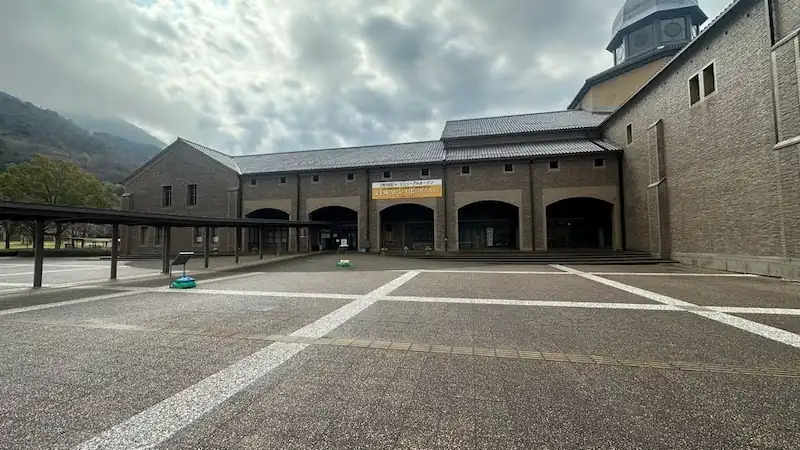
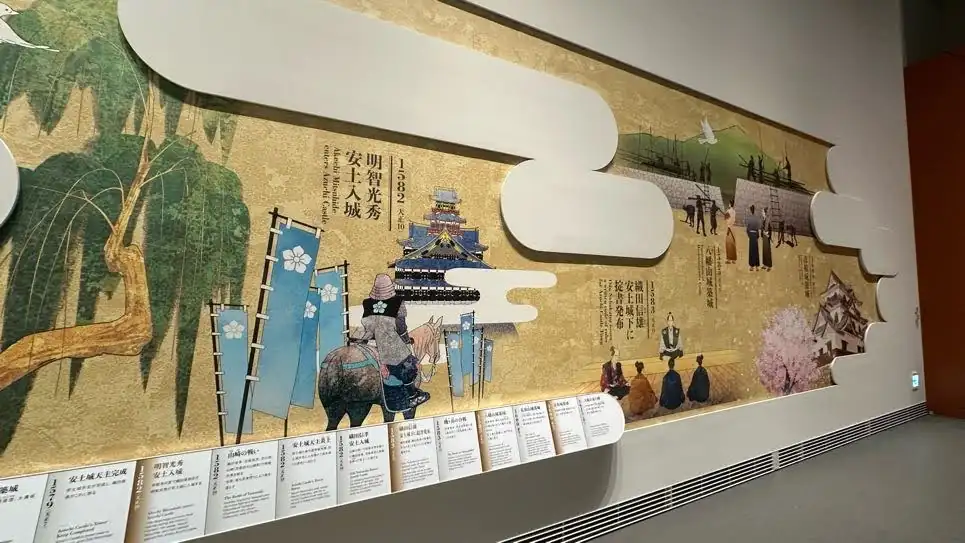
🏛 Overview
The Shiga Prefectural Azuchi Castle Archaeological Museum is a facility where visitors can learn about Azuchi Castle, built by Oda Nobunaga, and the history of the Sengoku period. Inside the museum, exhibits include reconstructed models of Azuchi Castle and excavated artifacts, providing insight into life at the time and Nobunaga’s legacy. The museum also offers interactive exhibits suitable for children, making history more accessible and engaging.
💰Admission
Adults: 600 yen
University students: 360 yen
Elementary and junior high school students: Free
⏱ Opening Hours
9:00–17:00 (last admission 16:30)
🌎Website
https://azuchi-museum.or.jp/information/use/
🗺 Address: 6678 Shimotoyoura, Azuchi-cho, Omihachiman City, Shiga Prefecture
🚶 Access
- By Train: About 25 minutes on foot from JR Biwako Line “Azuchi Station”
- By Car: About 30 minutes from Meishin Expressway “Ryuo IC” or “Yokaichi IC”
- By Rental Bicycle: About 10 minutes from Azuchi Station
- On Foot: About 30 minutes (approx. 2.3 km)
⏳ Suggested Visiting Time
- Quick visit: About 1 hour
- Thorough exploration: About 2 hours
📍 Highlights
- First Permanent Exhibition Room: Displays reconstructed models and excavated artifacts from Azuchi Castle, illustrating daily life and Nobunaga’s influence.
- Second Permanent Exhibition Room: Focuses on the Sengoku history of Ōmi Province, including Konan-ji and Odani castles.
- Special and Planned Exhibitions: Rotating themed exhibitions held for limited periods.
📌 Trivia
- Surprising Historical Context: Azuchi Castle disappeared only seven years after its completion, earning it the name “phantom castle.”
- Insider Information: The museum screens a high-definition CG reconstruction video of Azuchi Castle.
- Connection to Famous Figures: The museum houses numerous valuable materials related to Oda Nobunaga’s construction of Azuchi Castle.
Former Miyaji Residence
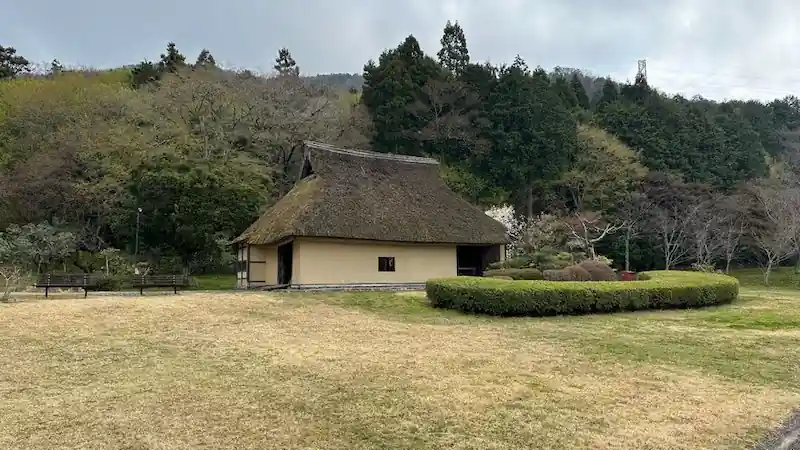
🏛 Overview
The Former Miyaji Residence is a farmhouse built in 1754 (Hōreki 4) during the mid-Edo period. It is an example of the “Yogo style,” a farmhouse style characteristic of the Hokubu region. Originally located in Kunitomo, Nagahama City, Shiga Prefecture, it has been relocated and preserved in Omi Fudoki-no-Oka in Azuchi-cho, Omihachiman City. The house features an irimoya-style thatched roof with gabled entrance, measuring 11.3 meters in length and 7.6 meters in width, with eaves on both the north and south sides. Its simple structure is a valuable remnant conveying rural life of the era and was designated as an Important Cultural Property of Japan in 1968.
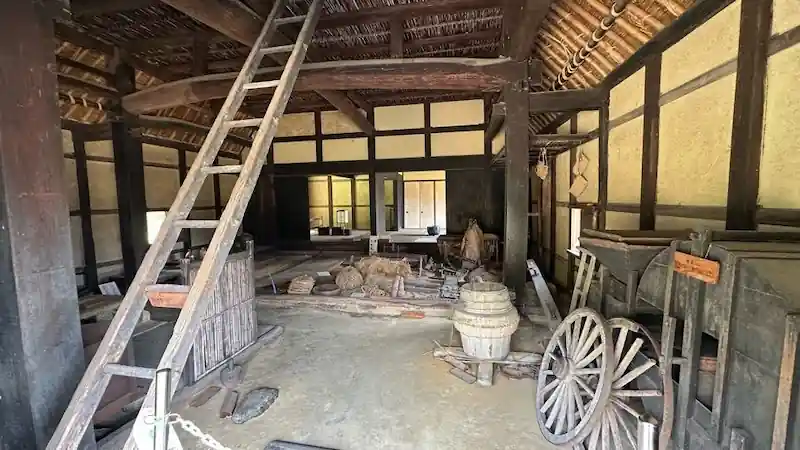
Omi Fudoki-no-Oka is a historical park adjacent to the Shiga Prefectural Azuchi Castle Archaeological Museum. In addition to the Former Miyaji Residence, it houses other relocated historical buildings from various parts of the prefecture, such as the Former Yanagihara School and the Former Azuchi Police Substation. These structures provide a tangible experience of Omi’s history and culture.
🗺 Address: 6678 Shimotoyoura, Azuchi-cho, Omihachiman City, Shiga Prefecture
🚶 Access
2-minute walk from the Shiga Prefectural Azuchi Castle Archaeological Museum
⏳ Suggested Visiting Time
- Quick visit: About 15 minutes
- Thorough exploration: About 30 minutes
📍 Highlights
- Former Miyaji Residence: Observe mid-Edo period farmhouse architecture up close and learn about rural life of the time.
- Historic Buildings in Omi Fudoki-no-Oka: Explore relocated structures such as the Former Yanagihara School and Former Azuchi Police Substation to experience the region’s history.
- Seasonal Appeal: In spring, cherry blossoms bloom around the area, creating a picturesque landscape alongside the historic architecture.
📌 Trivia
Connection to Famous Figures: The original location of the Former Miyaji Residence, Kunitomo, was renowned for firearm production from the Sengoku to Edo periods and home to many skilled gunsmiths.
Surprising Historical Context: The house originally stood in Kunitomo, Nagahama City, a town famous for gunsmithing, preserving the lifestyle of artisans and farmers of the era.
Insider Information: Omi Fudoki-no-Oka also features the Former Yanagihara School (a pseudo-Western style building from the Meiji era) and the Former Azuchi Police Substation, offering a glimpse into architecture and public facilities from that time.
Azuchi Castle Tenshu – Nobunaga no Yakata Museum
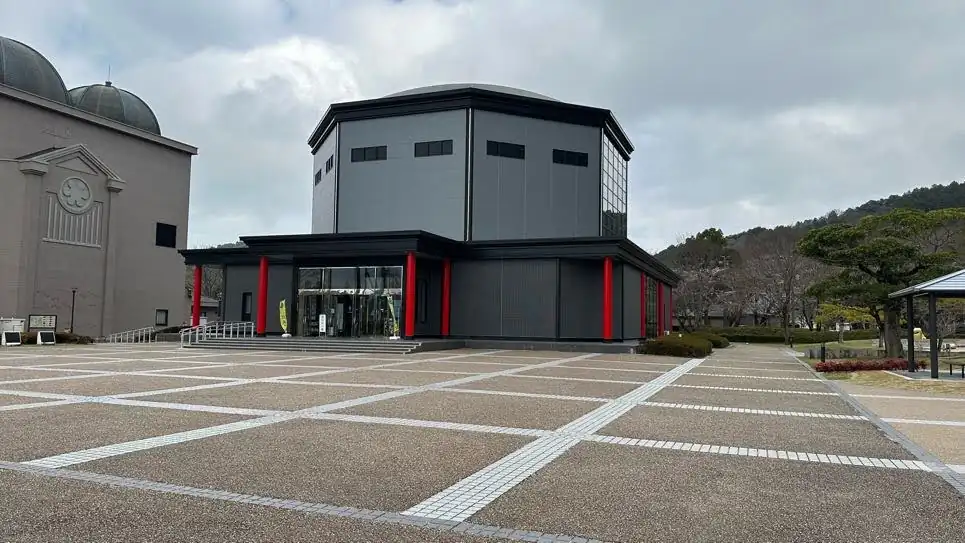
🏛 Overview
The Azuchi Castle Tenshu – Nobunaga no Yakata Museum features a full-scale reconstruction of the 5th and 6th floors of Azuchi Castle’s main keep (Tenshu), originally built by Oda Nobunaga. This reconstruction was first showcased at the 1992 Expo in Seville, Spain, as part of the Japan Pavilion, where it drew significant attention for its faithful reproduction, including the interior wall paintings. After the expo, the structure was relocated to Azuchi and has since been on display. The museum offers visitors an immersive look into the architectural techniques, artistic elements, and Nobunaga’s innovative vision for castle design. A VR theater also allows guests to experience the grandeur of Azuchi Castle through dynamic visual presentations.
💰Admission
General: 610 yen
Students: 350 yen
Elementary/Junior High Students: 170 yen
⏱ Hours
9:00–17:00 (last entry 16:30)
🌎Website
https://www.azuchi-shiga.com/n-yakata.htm
🗺 Address: 800 Kuwanomi-ji, Azuchi-cho, Omihachiman City, Shiga Prefecture
🚶 Access
- By Train: Approx. 25-minute walk from JR Biwako Line “Azuchi Station.”
- By Car: About 20 minutes from Meishin Expressway “Ryuo IC” or 40 minutes from “Hikone IC.”
- Parking: Free parking available for 150 regular cars and 4 large buses.
⏳ Suggested Visiting Time
- Quick visit: About 30 minutes
- Thorough exploration: About 1 hour
📍 Highlights
- Reconstructed Tenshu: Full-scale recreation of Azuchi Castle’s 5th and 6th floors, including meticulously replicated wall paintings.
- VR Azuchi Castle Theater: A 15-minute short film, “Brilliant Azuchi Castle,” projected on a 200-inch screen offers a vivid virtual tour of the castle’s splendor.
- Special Exhibitions: Periodic exhibitions focusing on Azuchi Castle and the Sengoku era.
📌 Trivia
- Surprising Historical Context: The reconstructed Tenshu was the main feature of the Japan Pavilion at the 1992 Seville Expo and recorded the highest number of visitors at the event.
- Insider Information: The museum’s VR theater utilizes state-of-the-art technology to vividly recreate the castle’s historical ambiance.
- Connection to Famous Figures: Azuchi Castle, built as Nobunaga’s base for unifying Japan, epitomized the cutting-edge architectural techniques of its era.
Tenka Fubu Song Monument
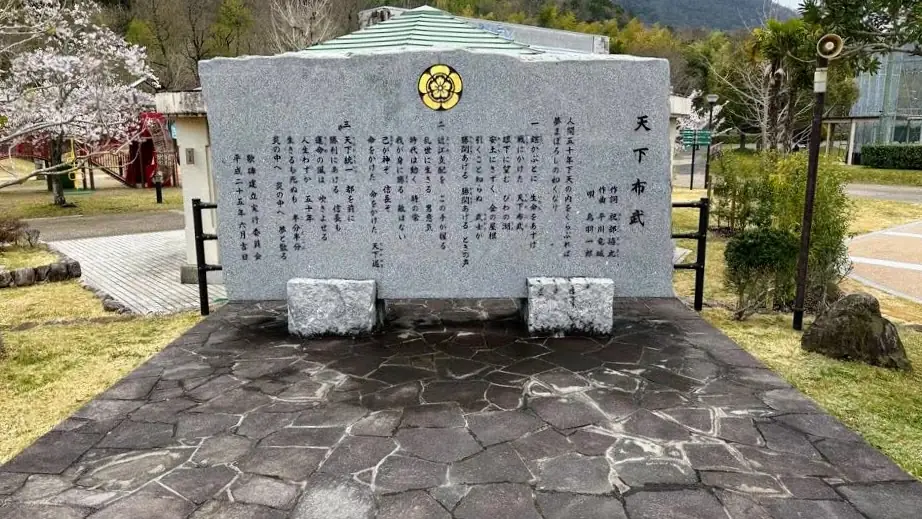
🏛 Overview
The “Tenka Fubu Song Monument” stands in the Spanish Plaza on the east side of the Nobunaga no Yakata Museum within the Azuchi Bunka no Sato complex in Omihachiman, Shiga. The monument commemorates the enka song “Tenka Fubu,” performed by singer Ichiro Toba. The unveiling ceremony took place on June 5, 2011, attended by many local dignitaries and supporters.
“Tenka Fubu” (天下布武) was a slogan adopted by Oda Nobunaga, meaning “Rule the realm by force.” It symbolizes Nobunaga’s ambition to unify the nation during the Sengoku period.
The monument is engraved with the lyrics of the song “Tenka Fubu,” serving as a reminder of Nobunaga’s ideals and historical legacy. Visiting this site alongside nearby attractions like the Azuchi Castle Ruins and Nobunaga no Yakata Museum offers a deeper appreciation of the Sengoku era.
🗺 Address: 800 Kuwanomi-ji, Azuchi-cho, Omihachiman City, Shiga Prefecture
🚶 Access
- By Train: Approx. 25-minute walk (about 2 km) from JR Biwako Line “Azuchi Station.”
- By Car: About 30 minutes from Meishin Expressway “Ryuo IC” or “Yokaichi IC.”
- By Rental Bicycle: Bicycles available at Azuchi Station; approx. 10-minute ride.
⏳ Suggested Visiting Time
- Quick visit: About 15 minutes
- Thorough exploration: About 30 minutes
📍 Highlights
- Song Monument: Features engraved lyrics of “Tenka Fubu” performed by Ichiro Toba.
- Spanish Plaza: A pleasant rest area with benches and greenery, ideal for taking a break during sightseeing.
- Seasonal Appeal: In spring, cherry blossoms bloom around the plaza, adding seasonal charm to the historic atmosphere.
📌 Trivia
- Surprising Historical Context: “Tenka Fubu” was first used by Nobunaga after he unified Mino Province and made Gifu Castle his base, signifying his intent to rule the realm through military might.
- Insider Information: The monument was erected through efforts of local volunteers and history enthusiasts to pass Nobunaga’s legacy to future generations.
- Connection to Famous Figures: The monument commemorates the song “Tenka Fubu” performed by renowned enka singer Ichiro Toba.
Azuchi Castle Museum
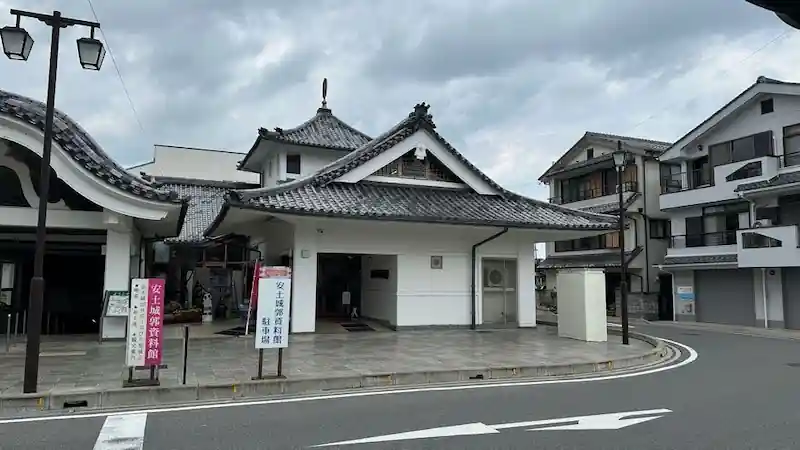
🏛 Overview
The Azuchi Castle Museum, located in Azuchi-cho, Omihachiman City, Shiga Prefecture, is dedicated to the history of the famed Sengoku-era stronghold built by Oda Nobunaga. The museum’s highlight is a meticulously crafted 1/20 scale model of Azuchi Castle, which reveals the castle’s intricate internal structure. The model is split into two sections, allowing visitors to closely observe each floor’s design and decorations, providing insight into the architectural techniques and Nobunaga’s refined aesthetic sense.
The museum also showcases exhibits on the historical background of Azuchi Castle, Nobunaga’s life, and the layout of the castle town, giving visitors a vivid glimpse into the Sengoku period. It remains a popular destination for history enthusiasts and tourists alike who wish to appreciate the grandeur and innovation of Azuchi Castle.
💰Admission
Adults: 200 yen
Students: 150 yen
Children: 100 yen
⏱ Hours
9:00 AM – 5:00 PM (last admission 4:30 PM)
🌎Website
https://www.azuchi-shiga.com/n-jyoukakusiryoukan.htm
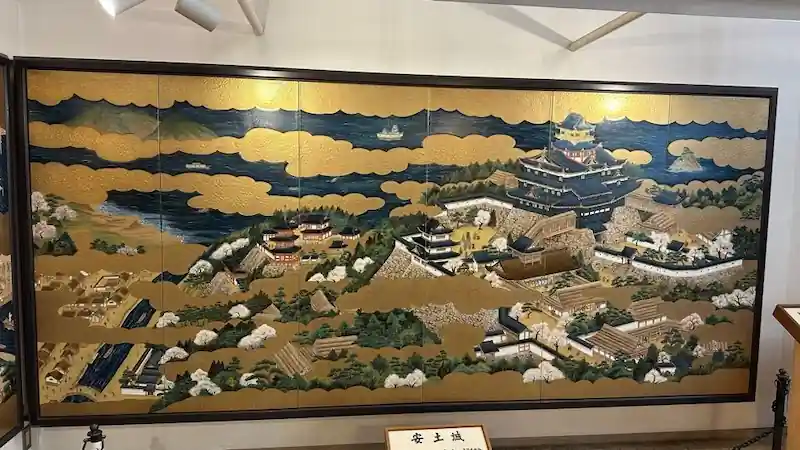
🗺 Address: 700 Konaka, Azuchi-cho, Omihachiman City, Shiga Prefecture
🚶 Access
Located directly in front of JR Azuchi Station
⏳ Suggested Visiting Time
- Quick visit: About 30 minutes
- Thorough exploration: About 1 hour
📍 Highlights
- 1/20 Scale Model of Azuchi Castle: A precisely reconstructed model revealing the castle’s interior design and layout.
- Historical Exhibits: Displays covering Nobunaga’s life, Azuchi Castle’s construction, and the castle town’s cultural context.
- Seasonal Features: Special exhibitions and events occasionally held during certain periods.
📌 Trivia
- Surprising Historical Context: Azuchi Castle was Nobunaga’s revolutionary stronghold for unifying Japan, showcasing groundbreaking design and luxurious decorations for its time.
- Insider Information: The detailed interior of the castle model allows visitors to appreciate the sophistication of 16th-century construction techniques.
- Connection to Famous Figures: The castle served as a venue where Nobunaga hosted powerful warlords and foreign emissaries, cementing its place in history.
Jogonin Temple
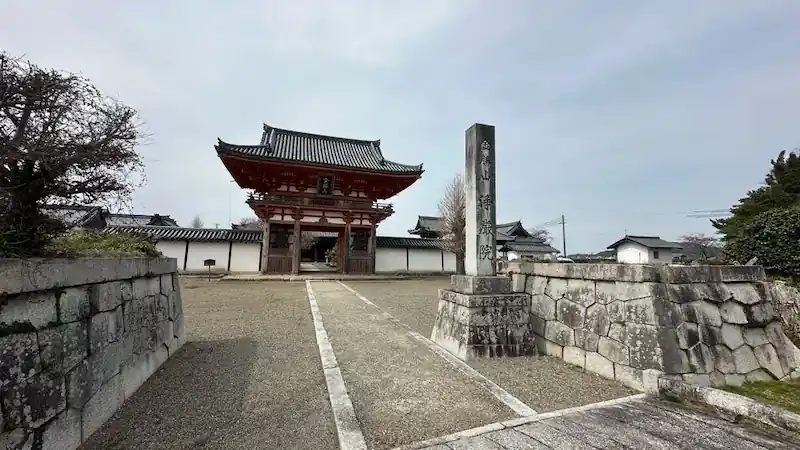
🏛 Overview
Jogonin Temple, located in Jionji, Azuchi-cho, Omihachiman City, Shiga Prefecture, belongs to the Jodo sect of Buddhism and bears the mountain name Kinshozan. It was founded in 1577 (Tensho 5) by Oda Nobunaga during the construction of Azuchi Castle, inviting the Jodo sect monk Jogonbo Myokan to establish it on the former site of Jionji Temple, the ancestral temple of the Sasaki Rokkaku clan of the Omi Genji. Jogonin is also renowned as the site of the “Azuchi Religious Debate” between the Jodo and Nichiren sects.
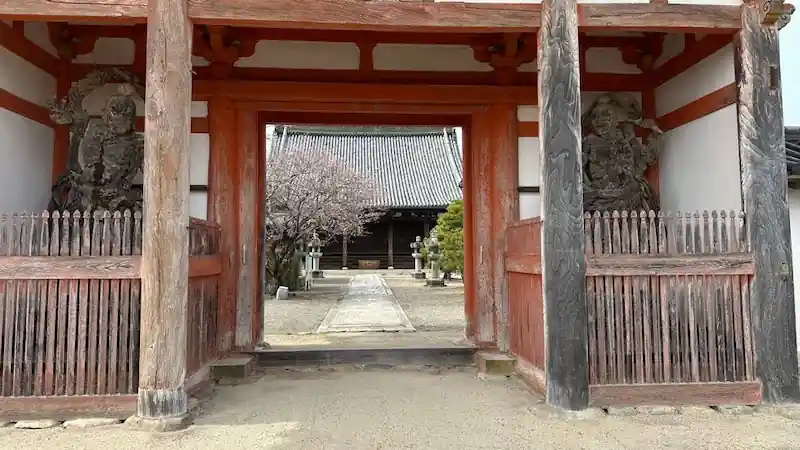

The temple grounds feature the Main Hall and the Gate, both designated Important Cultural Properties. The Main Hall enshrines the wooden seated statue of Amida Nyorai (Important Cultural Property). In recent years, Jogonin has also hosted contemporary art exhibitions, creating a unique space where history and modern art meet.
🗺 Address: 744 Jionji, Azuchi-cho, Omihachiman City, Shiga Prefecture
🚶 Access
- Nearest Station: 10-minute walk (approx. 700m) from JR Biwako Line “Azuchi Station”
⏳ Suggested Visiting Time
- Quick visit: About 30 minutes
- Leisurely visit: About 1 hour
📍 Highlights
- Main Hall: A late Muromachi period structure designated as an Important Cultural Property.
- Gate: Also an Important Cultural Property, exemplifying the architectural style of the late Muromachi period.
- Contemporary Art Exhibitions: Annual exhibitions by domestic and international artists, blending traditional temple spaces with modern art.
📌 Trivia
- Surprising Historical Context: Jogonin was built on the former site of Jionji, the ancestral temple of the Sasaki Rokkaku clan, and founded by Oda Nobunaga.
- Insider Tip: The temple hosts cultural events like contemporary art shows, making it a unique fusion of history and modern creativity.
- Connection to Famous Figures: Established by Nobunaga and renowned as the venue for the Azuchi Religious Debate, Jogonin played a pivotal role in Japan’s religious history.
Chokoji Temple (Relocated Back Gate of Sokenji Linked to Oda Nobunaga)
⭐ Recommendation
Historical Value: ★★★
Visual Appeal: ★★
Experiential Value: ★
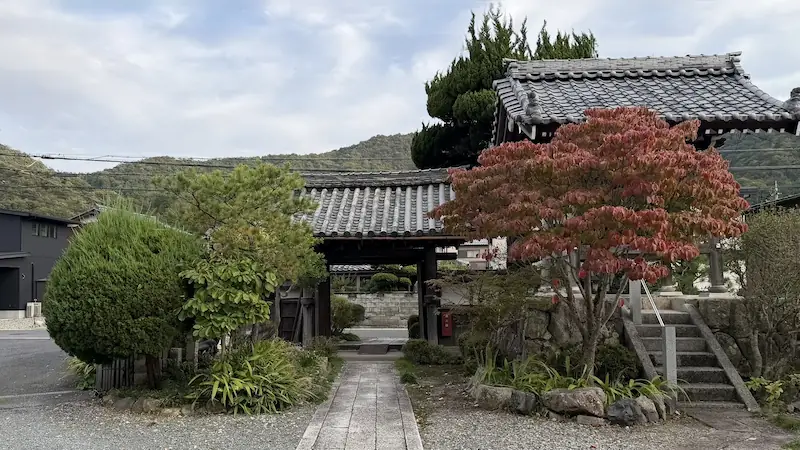
Chokoji Temple, located in Higashiomi City, Shiga Prefecture, is a Jodo Shinshu Honganji-ha temple. Its main gate was originally the back gate (kitchen gate) of Sokenji Temple, Nobunaga’s family temple within Azuchi Castle. In 1879, the gate was relocated here during the Meiji period. As one of the few surviving architectural elements directly linked to Azuchi Castle, it preserves Nobunaga’s legacy and evokes the spirit of the Sengoku era.
| Year of Relocation | 1879 (Meiji 12) — relocated from Sokenji Temple |
|---|---|
| Origin | Sokenji Temple, a Buddhist temple within Azuchi Castle founded by Oda Nobunaga |
| Structure & Features | Momoyama-period wooden gate (kitchen gate style), tiled and boarded roof |
| Preservation | Relocated in Meiji period; preserved and managed since; Prefectural Cultural Property |
| Current State | Fully intact gate preserved within temple grounds |
| Cultural Designation | Designated as a Shiga Prefectural Cultural Property (Chokoji Temple Gate) |
| Notes | An impressive 200-year-old ibuki (Japanese juniper) tree stands beside the gate |
🗺 Address: 343 Minamisuda-cho, Higashiomi City, Shiga Prefecture
🚶 Access
40-minute walk (approx. 2.8 km) from JR Azuchi Station
⏳ Suggested Visiting Time
Quick visit: about 15 minutes
Leisurely visit: about 30 minutes
📍 Highlights
- Main Gate (Former Sokenji Back Gate): Directly relocated from Nobunaga’s Sokenji Temple, offering a rare glimpse into Azuchi Castle’s religious structures.
- Ibuki Tree: A 200-year-old Japanese juniper beside the gate adds to the historical atmosphere.
- Momoyama Architecture: Observe the craftsmanship of roof tiles and wooden joinery from the late 16th century.
📌 Trivia
- Surprising Historical Context: While Sokenji’s main hall was destroyed by fire in 1854, its back gate survived and was relocated here — an exceptionally rare preservation of Azuchi Castle architecture.
- Insider Tip: This gate is one of the very few surviving physical remnants of Nobunaga’s religious complex within Azuchi Castle.
- Connection to Famous Figures: Sokenji was Nobunaga’s family temple, and this gate remains a tangible link to the warlord’s legacy.
Saikoji Temple (Jodo Sect Temple Associated with Oda Nobunaga)
⭐ Recommendation
Historical Value: ★★★
Visual Appeal: ★★
Experiential Value: ★★
Saikoji Temple traces its origins to 1579 (Tensho 7), when land was granted to monk Jōan by Oda Nobunaga following the “Azuchi Religious Debate,” where the Jodo sect emerged victorious. Later, under Toyotomi Hidetsugu, the temple was moved to its current location in Omihachiman and became a prayer temple for the castle town. The grounds feature Nobunaga’s memorial tower, Edo-period architecture, the folding screen “Reeds and Carp” by Maruyama Ōkyo, and stone lanterns attributed to Kobori Enshu. Rich in cultural treasures designated at both national and municipal levels, Saikoji exemplifies the deep involvement of warlords in religious affairs during the Sengoku era.
| Founded | 1579 (Tensho 7) in Azuchi |
|---|---|
| Founder | Monk Jōan (granted land by Nobunaga) |
| Features | Large Jodo sect complex; folding screen “Reeds and Carp” by Ōkyo; stone lanterns and multiple cultural properties |
| Relocation/Restoration | Relocated and expanded by Toyotomi Hidetsugu to Omihachiman |
| Current State | Main hall, study hall, bell tower, and gardens well preserved |
| Damage | Major buildings lost to fire in 1722; rebuilt thereafter |
| Cultural Designation | National and municipal cultural properties (e.g., Jizo statue, folding screen, stone lanterns) |
| Notes | Contains Nobunaga’s memorial tower, a popular site for visitors to pay respects |
🗺 Address: 726 Nakamura-cho, Omihachiman City, Shiga Prefecture
🚶 Access
23 minutes (approx. 1.7 km) from Omihachiman Station
⏳ Suggested Visiting Time
Quick visit: about 30 minutes (main hall, memorial tower, folding screen)
In-depth visit: about 1–1.5 hours (including garden and cultural properties)
📍 Highlights
- Nobunaga Memorial Tower: A memorial tower dedicated to Oda Nobunaga, where many visitors pause to pay their respects.
- Maruyama Ōkyo’s “Reeds and Carp” Folding Screen: A city-designated cultural property showcasing delicate Edo-period brushwork.
- Stone Lantern Attributed to Kobori Enshu: Garden lanterns reflecting refined Momoyama aesthetic sensibilities.
- Temple Layout and Gardens: Harmonious arrangement of halls and gardens offering seasonal beauty throughout the year.
📌 Trivia
- Site of the Azuchi Religious Debate: Nobunaga awarded temple land following the famous debate where Jodo sect triumphed over Hokke sect.
- Supported by Toyotomi Hidetsugu: Relocated to Omihachiman during castle town development and designated as a prayer temple.
- “Gaten no Uchi” Inscription: The memorial tower bears the phrase “Life is but a fleeting dream compared to heaven,” reflecting Nobunaga’s worldview.
Saikoji Temple embodies Oda Nobunaga’s religious policy and legacy, offering a wealth of cultural treasures amid serene surroundings. Visiting alongside Azuchi Castle ruins and related sites enhances an understanding of Sengoku-era thought and aesthetics.
Daibizan Kotakuji Temple
⭐ Recommended Rating
Historical Value: ☆
Visual Appeal: ☆
Experiential Value: ☆
Located in Nagano, Aishō Town, Echi District, Shiga Prefecture, Daibizan Kotakuji Temple is a tranquil temple of the Jōdo Shinshū Ōtani-ha (Higashi Hongan-ji branch), nestled in a quiet rural setting. The temple features a gate said to have been relocated from an old castle-temple complex, and it is traditionally linked to Sōken-ji—a temple once situated within Azuchi Castle, built by the famed warlord Oda Nobunaga during Japan’s Warring States period. Having moved beyond the grandeur of its castle-era past, Kotakuji now welcomes visitors with the calm atmosphere and gentle spirituality characteristic of the Edo and modern periods.
| Year Built | Unknown (Pre-modern era) |
|---|---|
| Builder | No historical record |
| Structure & Features | Jōdo Shinshū Ōtani-ha temple; gate reputedly relocated from another site |
| Restoration History | No detailed record available |
| Current Status | Temple buildings and grounds still preserved |
| Destruction or Damage | None confirmed |
| Cultural Property Designation | No official designation as a national or prefectural cultural asset |
| Notes | Local tradition claims the gate was relocated from Sōken-ji Temple within Azuchi Castle |
🗺 Address: 786 Nagano, Aishō Town, Echi District, Shiga Prefecture
🚶 Access:
Nearest Station: Approximately 16 minutes on foot (about 1.1 km) from JR Aichigawa Station
⏳ Suggested Visiting Time
Quick visit: approx. 5 minutes
In-depth exploration: around 20 minutes
📍 Highlights
- Main Gate (Relocation Legend): Believed to have been relocated from Sōken-ji Temple within Azuchi Castle. Even just viewing this gate—steeped in the castle’s legacy—evokes a sense of historical journey.
- Serene Grounds and Main Hall: Though modest in scale, the temple offers a tranquil setting for quiet reflection and prayer.
- Seasonal Beauty: In spring, the fresh greenery envelops the temple; in autumn, vivid foliage transforms the mountain village into a picturesque scene perfect for leisurely walks.
📌 Trivia
- An Unexpected Historical Connection: The temple’s main gate is said to have been relocated from Sōken-ji, a temple within Oda Nobunaga’s Azuchi Castle—a claim supported by local tradition, though detailed records remain scarce.
- A Hidden Gem: Small and rarely crowded, Kotakuji offers a peaceful retreat—ideal for travelers seeking calm moments off the beaten path.
- Connection to a Famous Figure: The temple’s association with Azuchi Castle evokes the legacy of Oda Nobunaga, allowing visitors to feel a subtle link to one of Japan’s most influential warlords.
Other Nearby Spots
Ume-no-gawa Spring (Water Source Associated with Oda Nobunaga)
⭐ Recommendation
Historical Value: ★★★
Visual Appeal: ★
Experiential Value: ★
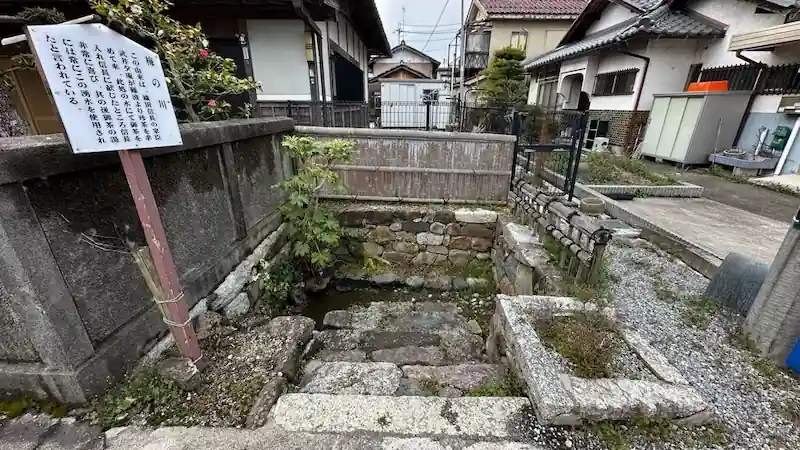
“Ume-no-gawa” is a historical spring once located in the castle town of Azuchi, Omihachiman, Shiga. It is said that Oda Nobunaga favored this water for tea ceremonies, after his retainer Takei Yūan served tea made from this spring, which greatly pleased Nobunaga. The spring reflects the culture of tea and hospitality during the Sengoku period.
| Name | Ume-no-gawa Spring |
|---|---|
| Associated Figures | Oda Nobunaga / Takei Yūan |
| Era | Tensho Period (1570s) |
| Features | Stone-framed water outlet; small-scale spring drawing from underground flow |
| Current Condition | Water flow mostly dried; only stone structure remains |
| Cultural Designation | Not designated; preserved as a local heritage site |
| Notes | Interpretive sign present; spring water rarely visible today |
🗺 Address:Azuchi-cho, Omihachiman City, Shiga Prefecture
🚶 Access
6-minute walk (approx. 400m) from Azuchi Station
⏳ Suggested Visiting Time
Quick visit: about 3 minutes
Including surrounding stroll: about 10 minutes
📍 Highlights
- Stone Spring Outlet: A simple yet historically rich remnant of the Sengoku era water source.
- Informational Sign: Provides background on Nobunaga’s tea culture and the spring’s historical significance.
- Castle Town Stroll: Perfect stop while exploring the Azuchi castle town area.
📌 Trivia
- Unexpected Historical Context: More than a water source, the spring symbolizes the refined tea culture of the Sengoku era and Nobunaga’s tastes.
- Hidden Detail: Locals still refer to it as “Nobunaga’s spring,” though the water flow has significantly diminished.
- Connection to Notable Figures: Takei Yūan, Nobunaga’s retainer and tea master, famously used this spring’s water to serve tea, leaving a lasting mark on Azuchi’s cultural history.
Statue of Oda Nobunaga at Azuchi Station
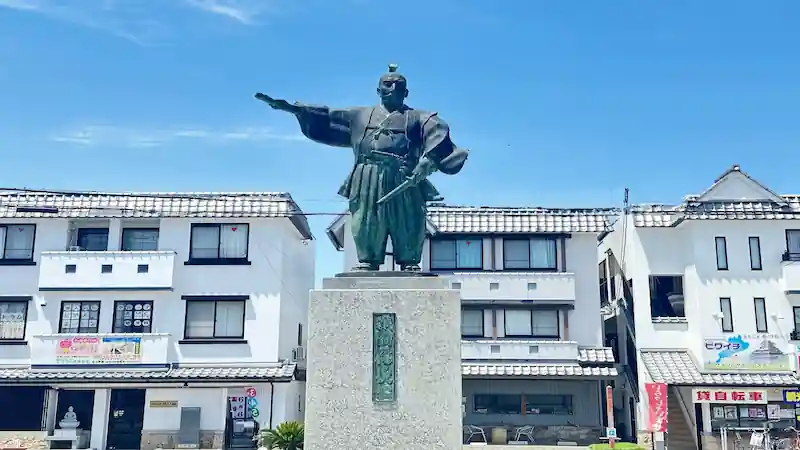
Kamitoyoura, Azuchi-cho, Omihachiman City, Shiga
Access
Directly outside the north exit of Azuchi Station
Site of Akechi Mitsuhide’s Residence
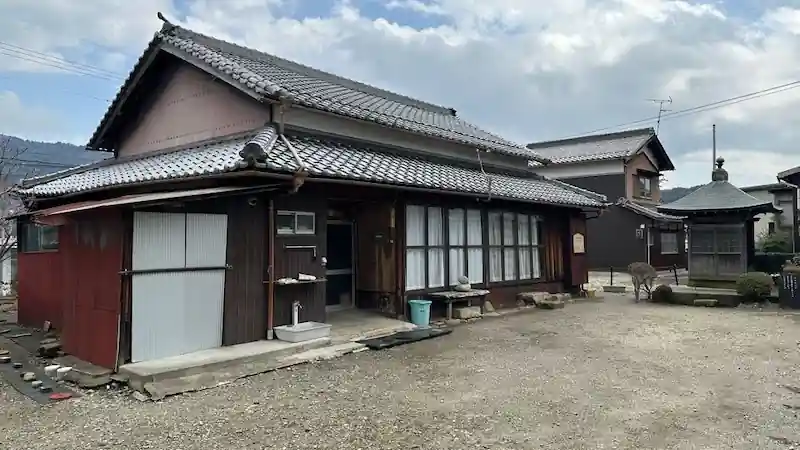
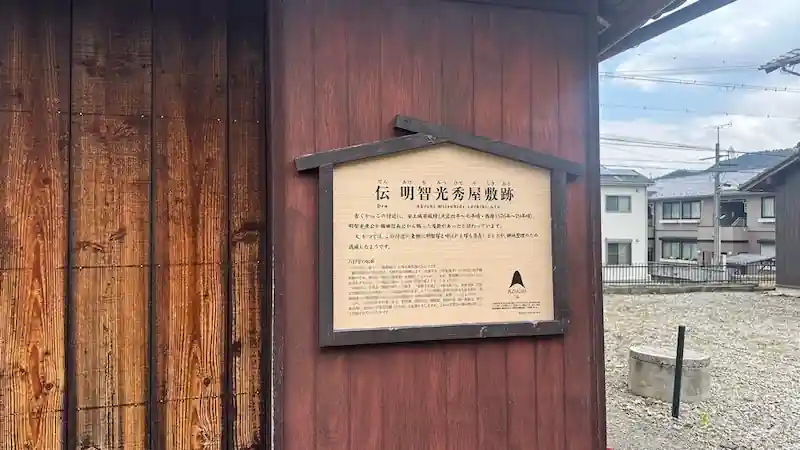
1093 Kamitoyoura, Azuchi-cho, Omihachiman City, Shiga
Access
Approx. 7-minute walk (500m) from Azuchi Station




comment